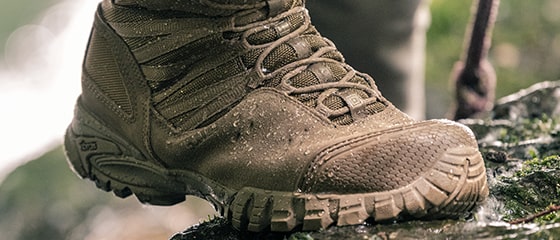There are places where you can skimp and save a bit of money with your airsoft loadout, but having good footwear is not one of them! Choosing the wrong boots, or failing to maintain them properly can make all the difference to having a superb day on site, or going home early, so Bill looks at a few pointers to making sure you stay comfy, and not just in the Safe Zone!
Just like your clothing system, your footwear choice is all-important year-round, but especially so when the weather turns wet, cold, and even snowy! A good desert boot will inherently be made with less insulation than a winter, or indeed even a temperate model, so as much as a good waterproof technology will keep your feet dry the boot overall will leave you with cold feet, or worse, on a snowy morning, waterproof socks can help if you have an unlined summer boot, but do bear in mind that these will fill the inner volume of the boot, and that can lead to head loss via transmission so your feet will be dry, but still feel cold. Cuff height may also differ, as in general a winter boot will have a higher cuff to keep out snow and spindrift; I was at a game just not so ago where I stepped into a water-filled pothole deeper than the height of my desert boot cuff, and although they’re membrane-lined water does tend to get in through the big hole on the top where your foot goes in!
So why not just wear wellies? Well, two things here really; firstly wellies are pretty much always not going to be breathable, so although they will keep water out, and with specialist socks be warm, but they will also keep moisture in; someone once told me that we have more than 250,000 sweat glands in each foot, making them the most perspiring parts of your body. Your body can produce as much as a pint of sweat per day per foot, and if you’re wearing wellies most of that will stay inside the boot! Secondly most basic wellies offer very little support.
You’ve also got to build into this equation that boot manufacturers make different outsole units for different conditions; this may not on the face of it be a major concern, but if the tread pattern of the outsole has been designed for warm, dry conditions how will it fare in wet grass or on wet-leaf covered rock? Let me tell you… not very well at all, and you’re seriously asking for a slip which could lead to a turned ankle or worse.
A waterproof exterior or membrane is a crucial boot feature to keep you protected from the elements. By using breathable technologies waterproof boots prevent moisture from building up and potentially forming harmful bacteria and blisters, but also allow for perspiration to get out. For even greater protection in the winter months, look for boots that are both waterproof and insulated. Insulated linings keep warmth inside the boot so that you can stay comfortable and protected during cold weather games.
Winter boots go through a lot; they are subjected to rain, snow, mud, slush, salt, and a whole range of crud on site; by the end of a winter season poorly cared for boots will repay your lack of care by failing to maintain waterproofness, looking like sh1t or even falling apart completely! Even the best boots, leather or synthetic, will put up with plenty of muck and water on site, but mud can ruin your boot’s outer if it stays on too long, so when you get home stick your boots under the tap and then scrub with a stiff brush. Dry them with a boot dryer or in a warm room, but never put boots next to the fire or on top of a radiator as too much heat can crack the leather and melt the soles!
Remove the insoles if you can at the same time you scrub the boots clean (ish!); insoles hold moisture, and will start to get soft and start to rot if you leave them in for an extended period of time. The same goes for boots made from synthetic materials; wet insoles can also become smelly and full of bacteria if they’re allowed to sit in the boot. Just let them dry overnight, and they should be fine again.
Water will ruin leather, so you’ll need to reapply a Durable Water Repellant treatment once in a while, and you also want nylon and cordura tactical models to keep water out once the DWR coating wears off. I use items from the Nikwax Footwear Care Kit because it’s easy to use (and PFC-free). You should reapply a waterproofing agent whenever you notice that the outer materials, leather or synthetic, are becoming saturated and holding water. You don’t need to use much, just coat the entire boot with one thin layer, let that dry and you’ll be good to go again in no time.
We may all face a range of weather conditions on any site through the year, so don’t let your boots hold you back from enjoying the game!







